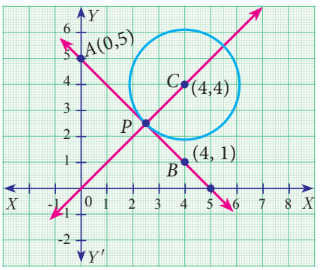EQUATION OF LINE PASSING THROUGH POINT OF INTERSECTION OF TWO LINES
Subscribe to our ▶️ YouTube channel 🔴 for the latest videos, updates, and tips.
Example 1 :
Find the equation of the straight line which passes through the point of intersection of the straight lines 5x - 6y = 1 and 3x + 2y + 5 = 0 and is perpendicular to the straight line 3x - 5y + 11 = 0.
Solution :
To find the point of intersection of any two lines, we need to solve them
5x - 6y = 1 --(1)
3x + 2y = -5 ----(2)
5x - 6y = 1
(2) x 3 => 9x + 6y = -15
----------------
14 x = -14
x = -1
Substitute x = -1 in the first equation
5 (-1) -6 y = 1
-5 - 6y = 1
-6 y = 1 + 5
-6y = 6
y = -1
Point of intersection of those two lines is (-1,-1)
Slope of the perpendicular line 3x - 5y + 11 = 0
m = -3/(-5)
= 3/5
Slope of the required line = -1/m
= -1/(3/5)
= -5/3
Equation of the line :
(y - y₁) = m (x - x₁)
(y - (-1)) = (-5/3) (x - (-1))
3 (y + 1) = -5 (x + 1)
3 y + 3 = - 5 x - 5
5 x + 3 y + 5 + 3 = 0
5 x + 3y + 8 = 0
Example 2 :
Find the equation of the straight line joining the point of intersection of the lines 3x – y + 9 = 0 and x + 2y = 4 and the point intersection of the lines 2x + y – 4 = 0 and x – 2y + 3 = 0
Solution :
To find the point of intersection of any two lines we need to solve them
3x – y + 9 = 0 ---- (1)
x + 2y - 4 = 0 ---- (2)
(1) - (2)
3x – y + 9 = 0
(2) x 3 3x + 6y - 12 = 0
(-) (-) (+)
-----------------
- 7y + 21 = 0
7y = 21, y = 3
Substitute y = 3 in the first equation
3 x - 3 + 9 = 0
3 x + 6 = 0
3 x = - 6
x = -6/3 = -2
the point of intersection is (-2, 3)
2x + y – 4 = 0 ---- (3)
x – 2y + 3 = 0 ---- (4)
(1) - (2)
2x + y - 4 = 0
(2) x 2 2x - 4y + 6 = 0
(-) (+) (-)
-----------------
5 y - 10 = 0
5y = 10
y = 2
Substitute y = 2 in the third equation
2 x + y - 4 = 0
2 x + 2 - 4 = 0
2 x - 2 = 0
2 x = 2
x = 1
the point of intersection is (1, 2)
Equation of the line:
(-2, 3) and (1, 2)
Slope of the line = (2 - 3) / (1 + 2)
= -1/3
(y - y1) = m(x - x1)
(y - 3) = -1/3 (x - (-2))
3(y - 3) = -1(x + 2)
3y - 9 = -x - 2
x + 3y = -2 + 9
x + 3y = 7
Example 3 :
The line joining the points A(0, 5) and B(4, 1) is a tangent to a circle whose centre C is at the point (4, 4) find
(i) the equation of the line AB.
(ii) the equation of the line through C which is perpendicular to the line AB.
(iii) the coordinates of the point of contact of tangent line AB with the circle.
Solution :
i)

Slope of the line passes through two points A(0, 5) and B(4, 1)
Slope = (1 - 5) / (4 - 0)
= -4/4
= -1
Equation of line :
(y - y1) = m(x - x1)
y - 5 = -1(x - 0)
y - 5 = -x
x + y = 5
Equation of the line AB is x + y = 5
ii)
Slope of the line passes through C = -1/(-1)
= 1
Equation of the perpendicular line to AB passes through C:
(y - y1) = m(x - x1)
y - 4 = 1(x - 4)
y = x - 4 + 4
y = x
iii) By finding the point of intersections of x + y = 5 and y = x, we get the required point.
x + x = 5
2x = 5
x = 5/2
Applying the value of x in y = x
y = 5/2.
So, the required point is (5/2, 5/2).
Example 4 :
Find the equation of a straight line joining the point of intersection of 3x + y + 2 = 0 and x - 2y - 4 = 0 to the point of intersection of 7x - 3y = -12 and 2y = x + 3
Solution :
3x + y + 2 = 0 ----(1)
x - 2y - 4 = 0 -----(2)
2 (1) + (2)
6x + 2y + 4 = 0
x - 2y - 4 = 0
----------------
7x + 0 = 0
x = 0
Applying x = 0 in (1), we get
3(0) + y + 2 = 0
y = -2
The point of intersection of these two lines are (0, -2).
7x - 3y = -12------(3)
2y = x + 3
-x + 2y = 3------(4)
(3) + 7(4)
7x - 3y = -12
-7x + 14y = 21
-----------------
11y = 9
y = 9/11
Applying the value of y in (3)
7x - 3(9/11) = -12
7x - (27/11) = -12
7x = -12 + (27/11)
7x = (-132 + 27)/11
7x = -105/11
x = -15/11
The point of intersection of these two points is (-15/11, 9/11)
(0, -2) and (-15/11, 9/11)
Slope of the line = (9/11 + 2) / (-15/11 - 0)
= (9+22)/11 / (-15/11)
= 31/15
Equation of the line :
(y + 2) = 31/15(x - 0)
15(y + 2) = 31x
15y + 30 = 31x
31x - 15y = 30
Subscribe to our ▶️ YouTube channel 🔴 for the latest videos, updates, and tips.
Kindly mail your feedback to v4formath@gmail.com
We always appreciate your feedback.
About Us | Contact Us | Privacy Policy
©All rights reserved. onlinemath4all.com

Recent Articles
-
US Common Core K-12 Curricum Algebra Solving Simple Equations
Jan 07, 26 01:53 PM
US Common Core K-12 Curricum Algebra Solving Simple Equations -
10 Hard SAT Math Questions (Part - 4)
Jan 05, 26 06:56 PM
10 Hard SAT Math Questions (Part - 4) -
10 Hard SAT Math Questions (Part - 3)
Jan 05, 26 06:34 PM
10 Hard SAT Math Questions (Part - 3)

